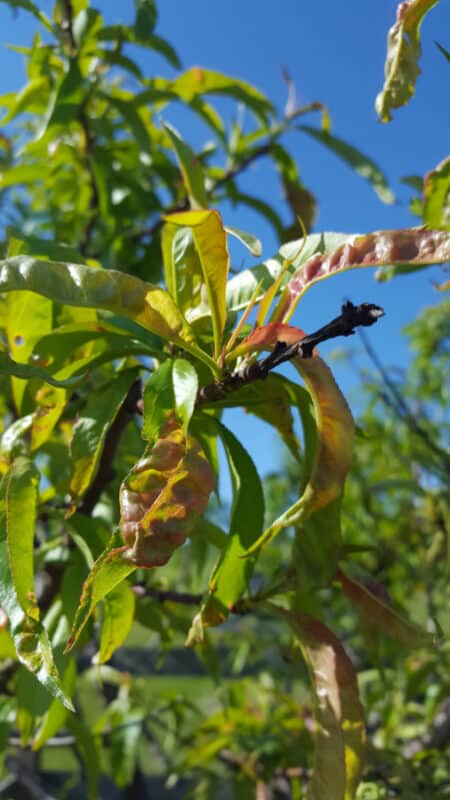Lawn
• To prevent lawn suffocation, rake fallen leaves.
• Review lawn service contracts and make changes.
• Tune up and repair the mower to get a jump on the season.
• Avoid injury to the lawn when the soil is frozen by keeping foot traffic to a minimum.

Landscape
• Draw garden layouts to assist with the planning process.
• Review garden notes about successes and failure in the garden.
• Take a soil test if one has not been done the last five years.
• On warm days, prepare garden soil for early planting.
• Incorporate manure or compost into garden areas for soil improvement.
• Avoid working the soil when it is wet.
• Check dates on stored seed packets. Sprout a few from each packet in a moist paper towel. Discard packets with poor results.
Vegetables and Fruits
Time for Peach Leaf Curl Control
If you have ever seen emerging peach leaves that are puckered, swollen, distorted and reddish-green color, you have seen peach leaf curl.
Uncontrolled, this disease can severely weaken trees because of untimely leaf drop when leaves unfurl in the spring. Fortunately, peach leaf curl is not that difficult to control if the spray is applied early enough.
By the time you see symptoms, it is much too late. As a matter of fact, fungicides are ineffective if applied after buds begin to swell. Recent cold temperatures should keep trees in tight bud long enough to find a window for application. Don’t spray when temperatures will fall below freezing before the spray dries.
Peach leaf curl can be controlled by a single fungicide application either in the fall after leaf drop or in the spring before bud swell.
There are several fungicides labeled for this disease including
Bordeaux, liquid lime sulfur, and chlorothalonil (Ortho Garden Disease Control, Fertilome Broad Spectrum Fungicide, GardenTech Fungicide Disease Control, Gordon’s Multipurpose Fungicide, and Daconil).
Thoroughly cover the entire tree during application. Note that it is much easier to achieve good spray coverage if the tree is pruned before spraying. (WU)

Dormant Oil Sprays for Fruit Trees
There are a number of dormant sprays used on fruit to control various diseases and insects, but a dormant oil spray is designed to control scale insects. If you have a problem with scale, now is the time to start looking for an opportunity to spray. Normally spray should be applied by March 1, especially with peaches and nectarines. Apples are tougher, and application may be delayed up to the green tip stage. Temperatures need to be at least 40 degrees so spray has a chance to dry before freezing. If the spray does freeze before it dries, plant injury can occur. Applying the spray during the morning will help insure that it dries properly. Thorough coverage of limbs, branches and twigs is vital for good control. (WU) K State Extension Service.
• Start broccoli, cauliflower, and cabbage transplants.
Flowers
• Cut branches from spring blooming shrubs (Forsythia, Pussy Willow) and bring indoors in February for early bloom. Place them in a large vase with warm water, and seal tight in a plastic bag to provide humidity. In a few days check to see if buds are swelling. They should bloom in 2-3 weeks.
• Start seeds for transplanting in the spring.
• Check fall planted perennials and water if needed.
• Watch for frost heaving of tender perennials and cover if needed.
• Replenish winter mulch around roses and other plants.
• Check bulbs in storage and discard if rotted.
Trees and Shrubs
• Check for rabbit damage on young trees and shrubs.
• Water fall planted trees, shrubs, and evergreens if the soil is dry and not frozen.
• Apply dormant oil for control of scale and mites.
Pruning
• Fruit trees like apples, pears and cherries, grapes, raspberries, and blackberries.
• Peach and nectarines just prior to bloom time.
• Begin spring pruning. However, do not prune spring flowering trees and shrubs until after bloom.
• Cut twigs and branches of spring shrubs and bring them indoors to add a splash of spring color.
• Carefully remove snow from limbs with a broom.
Houseplants
• Check plants for insects, mites or other problems and treat as needed.
• Withhold fertilization until spring arrives.
• Remove dust build up on plants by placing in the shower and washing off.
• Water as needed, avoid letting roots set in water.
• Keep plants out of hot or cold drafts.
This information is brought to you from Nadine Champlin, Designer, Grimms Gardens; and Johnson County K-State Research and Extension. http://www.johnson.ksu.edu/p.aspx?tabid=137


